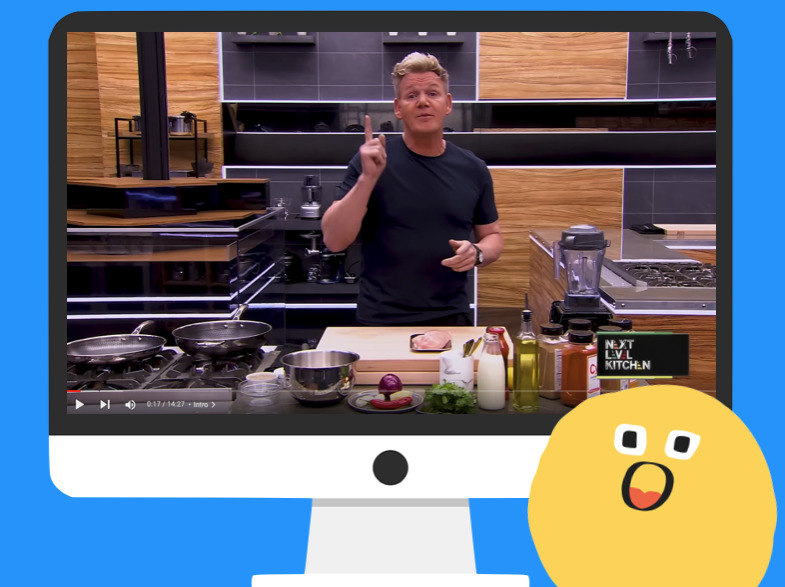
I recently watched a video of Gordan Ramsey cooking a ‘curry in a hurry’ (a butter chicken dish).
I was spellbound by the way Ramsey seamlessly cooked this dish. He was in flow and fully focused on the task of cooking the butter chicken.
What allowed him to whip up this dish plus a serving of rice in under 15 minutes?
Being organised helped a lot. Before he started cooking, chef Ramsey had all the ingredients and cooking utensils out on the bench, ready to go.
In chef’s speak, he had prepared the mise en place.
Mise en place is a culinary skill that can help us to study and work more efficiently. In this article, I explore this concept and how you can apply it to your life to help you stay calm, focused, and in control of your studies.
The mise en place is a French term that translates to “putting in place”. It means a place for everything and everything in its place.
Everything the chef needs is within arm’s reach. When it’s time to start cooking the dish, the chef knows where everything is. This allows the chef to focus on cooking the dish and stay calm and grounded under pressure.
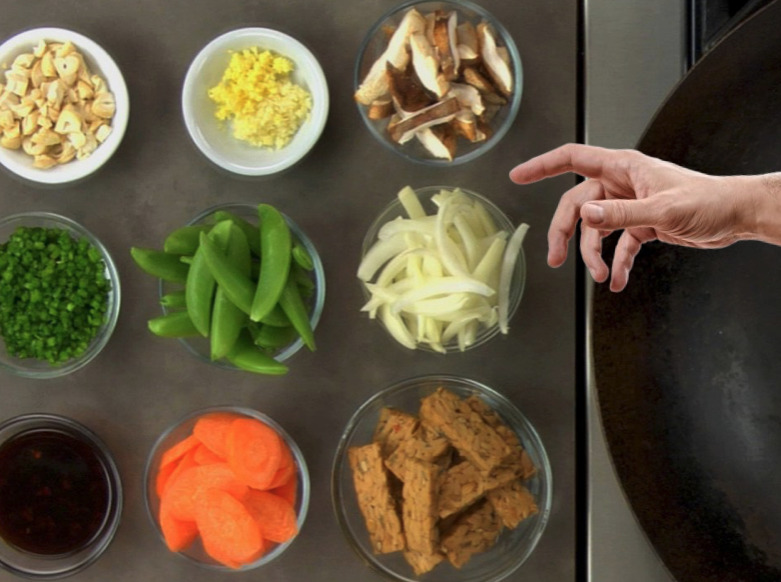
In the book Kitchen Operations (a textbook for hospitality students and apprentice chefs), the authors write about the importance of being organised in the kitchen. They state:
“The ability to work in an organised manner is possibly the most important quality that anyone working in the preparation and service of food can demonstrate. You must develop this ability to complete the expected workload in the time available. Failure to be methodical in your approach will reduce efficiency and will lead to feelings of stress and frustration.”
The mise en place helps the chef avoid unnecessary stress and frustration.
Imagine the following scenario . . .
A chef starts cooking a pasta sauce.
The chef realises 10 minutes in that he is missing a key ingredient (tins of tomatoes).
The chef has to run to the shops to buy the tomatoes.
Chefs can’t afford to have that happen. They are time-pressured. They need to get meals out quickly to hungry customers.
The mise en place helps chefs avoid stressful situations like this. It can also help you decrease unnecessary stress, drama, and frustration associated with homework and study.
Before starting your work, set yourself up with everything you need to complete the task.
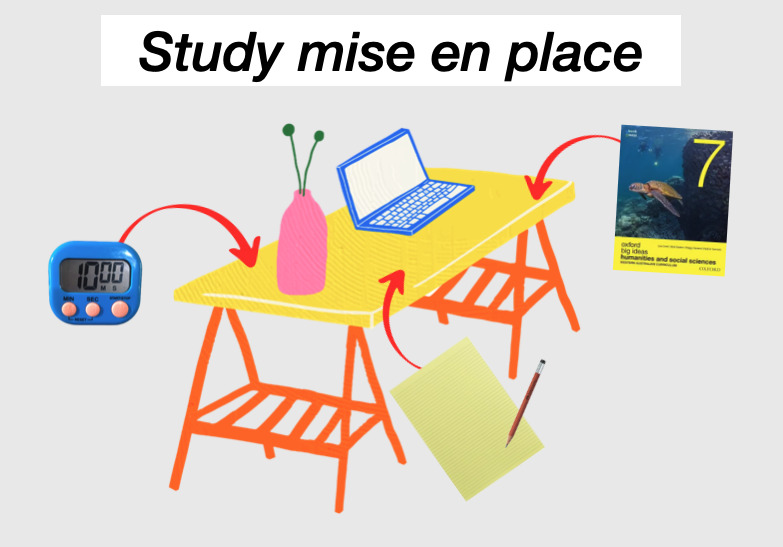
Think of this as the study desk mise en place. Ideally, you want to have a dedicated study space where everything is already set up. This saves you time, as you don’t have to set things up and pack things away after each study session.
But your desk isn’t the only space you can set up and prepare. In the world of study, you have other spaces you need to manage (e.g., a computer, school bag, pencil case, and locker). With each of these spaces, you need to ask:
“What items do I need in this space for my work to flow smoothly?”
It also helps to ask:
“What items don’t I want in this space?”
Just like a chef doesn’t want cockroaches, cats, and rats running around the kitchen and restaurant (or a visit from the local health inspector), there are things you want to keep out of your study space.
Remove anything that throws you off your game (i.e., makes you feel bad, distracted, overwhelmed, and upset) from your study space.
Here’s my list of things I want to keep out of my study space:
• My smartphone
• Long to-do lists
• Visual clutter
The point is to remove any friction points from your environment (anything that will slow you down and make it difficult to do your work).
The mental mise en place cannot be overlooked. This is the mental preparation part of the study process.
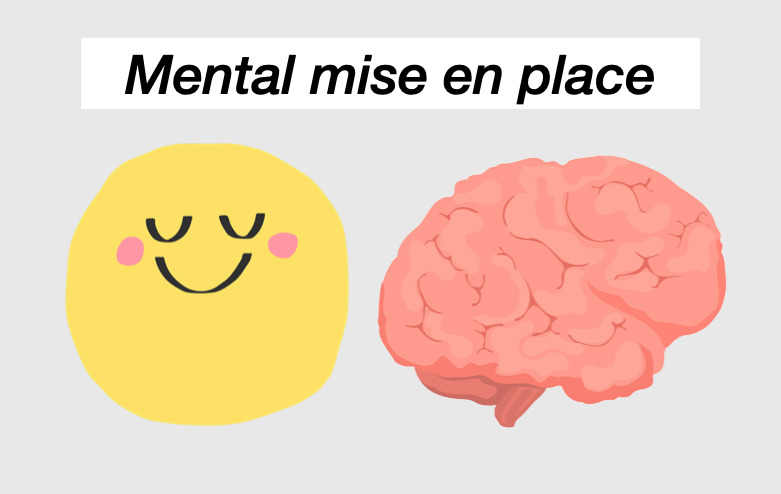
Ask yourself:
What must I do to mentally prepare myself for deep work/study?
Most of us can’t just scroll on our social media feed for an hour and launch straight into doing focused study. We need to get into the right headspace.
To be clear, I don’t mean you need to feel motivated, inspired, or in the right mood to study. Too often, we wait for motivation to strike, and it never comes. However, it certainly helps to be calm, focused, and grounded.
My mental preparation for the workday starts the evening before. Too many late nights have taught me that to wake up feeling calm and grounded, I need to go to bed at a reasonable hour.
When I wake up, I protect this mental calm by:
• Going for a walk or lifting heavy weights
• Doing a mini meditation (usually 3-5 minutes)
• Eating a healthy breakfast
• Avoiding checking my email and touching my computer first thing
• Journaling or mind mapping with pen and paper
I stay away from screens for as long as possible. This is essential for cultivating a calm mental state where I feel proactive and in control of my day.
I know I’m in trouble if I skip too many of the things on the list and start the day by checking my email. It becomes much more challenging to focus and get things done.
What is a pest of the mind?
It is anything that overstimulates the mind and leaves one feeling frenzied, scattered, and/or jangled.
Here’s the thing about learning information at a deep level: it requires you to slow down. You cannot rush it, like a 15-minute butter chicken dish.
But we engage with people, places, and things on a daily basis that speed up our thinking. In this overstimulated, wired mental state, learning feels like a hard slog.
Here’s a tip: start to notice the things that leave you feeling overstimulated. It can be incredibly liberating to cut back on these things or eliminate them completely from your life.
I am constantly tweaking my workspace and experimenting with different tools to help me click into a state of flow with my work. Here are some tools that I’m currently enjoying having as part of my study mise en place:
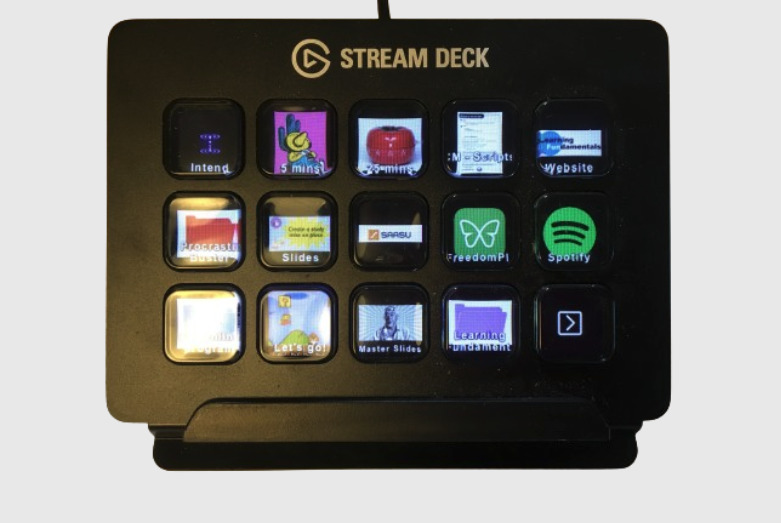
Technically, this is a gaming device that allows gamers who stream to switch scenes, adjust audio, etc at the tap of a button. I’m not a gamer, but I use my Stream deck to get started with various tasks and projects I feel resistance towards.
Instead of thinking, “Where is this file located? How do I get to it?” I tap a button on the Stream deck and it opens the file up. I tap another button, and it opens an application I frequently use.
No more frustrating clicking through numerous folders trying to find the document I need! The Stream deck helps to remove a big mental barrier and kick-start the work process with ease.
Stream decks aren’t cheap but if you can find one secondhand or on special like I did, they are well worth it.
Staying hydrated is super important. I fill a big jug with water every morning and place it on my desk with a glass. If water is within arm’s reach and I can see it, I find myself taking regular sips throughout the day.
I used nasty, cheap pens for years. Being a sucker for free stuff, I collected free pens at career expos and university open days. Without even realising it, these pens caused me a great deal of frustration and irritation.
These days, when it comes to pens, I don’t mess around with junk. There’s one pen I love using: the uniball signo (0.7). It’s a gel pen (you can find them at Officeworks). Writing with this pen is an absolute pleasure.
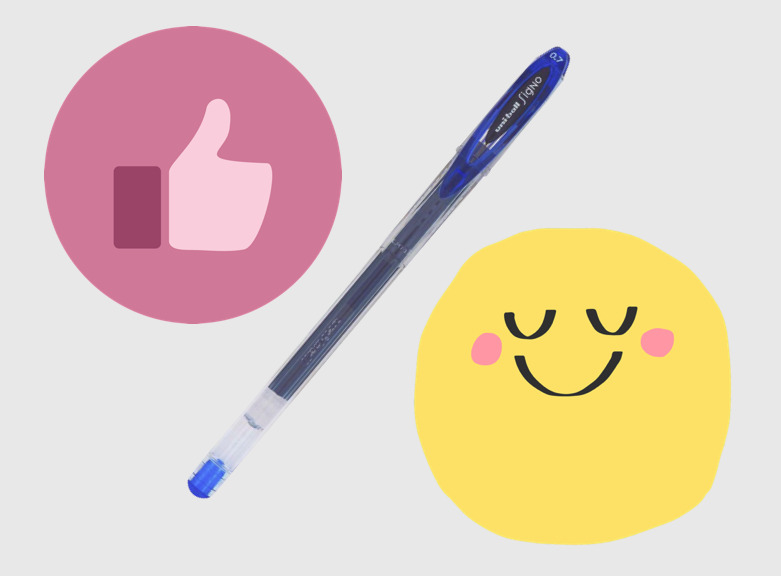
As Kevin Kelly says:
“Take note if you find yourself wondering “Where is my good knife?” or “Where is my good pen?” That means you have bad ones. Get rid of those.”
It’s super handy to have a notepad to jot down ideas and random thoughts as they arise. I recently discovered Rhodia notepads (a recommendation by The Pen Addict, Brad Dowdy). Writing on this paper feels like writing on butter!
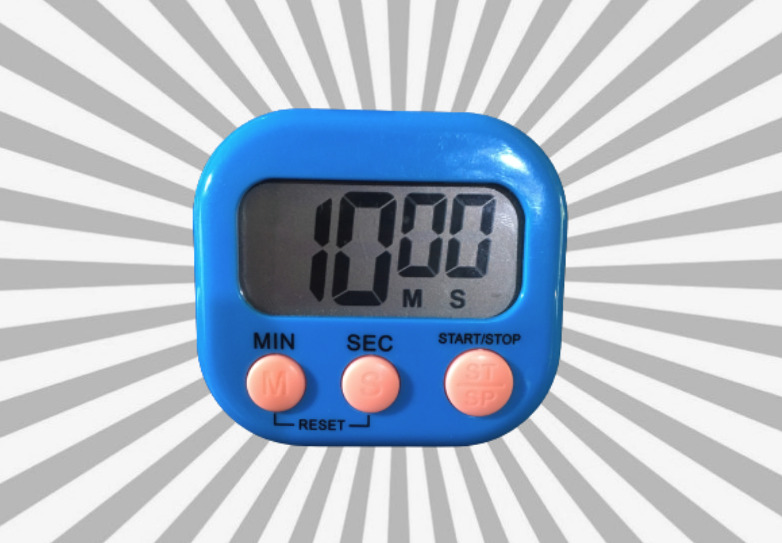
Whenever I notice I’m procrastinating, I’ll set my timer for 10 minutes and say, “All I need to do is 10 minutes on this task. That’s all. Just 10 minutes”. I set the timer and away I go.
Other times, when my workspace looks like a mess, I’ll set a timer for 3 minutes and spend that time getting things back in order.
My planner tells me what to do and when to do it. For the last 6 weeks, I have been experimenting with Cal Newport’s time blocking method (planning my day in hourly blocks). It sounds torturous, but it’s strangely liberating.
When I open my planner, I can see what is happening for the week, but I don’t have a sense of the bigger picture. This is why I printed out a massive (A0 size) year-in-a-glance planner to schedule all my presentations, holiday breaks, special events, etc.
Having this calendar makes me feel more in control of my life. I can see when I have busy periods of presenting and when I need to balance those periods with extra rest time to sustain myself. I can also see events and deadlines relatively to where I am now.
These are just a few things I love having in my study/work mise en place. But we’re all different, so you need to figure out what works best for you.
When I recently asked a group of high school students what items they would need in their study mise en place, here’s what they came up with:
• Snacks
• Phone
• Pencil case
• Squishmallows
The first three suggestions didn’t surprise me, but the squishmallows sure did (the students were shocked that I’d never heard of a squishmallow before). I had to google them (they are soft toys).

But I get it.
A squishmallow is fun.
It’s comforting.
It makes you feel good.
If something makes you feel good, go put it on your desk. Because if you feel good, it will be easier to think and learn.
The mise en place is a skill that can help all of us (not just chefs) focus on the task at hand. The point is you need to make your study mise en place work for you. You need to find the combination of ingredients that hits the spot.
Like a top chef has their favourite chopping knife, you’ll have your favourite pen. Spend some time experimenting with various tools and different work setups. By creating a more streamlined and organised study space, you’ll get that time back. Plus, you’ll find it’s much easier to get going and keep going with your work.
Share This:

In our modern world, overwhelm and distraction threaten to constantly derail us.
As artist Austin Kleon states in his book Keep Going:
“Your attention is one of the most valuable things you possess, which is why everyone wants to steal it from you. First you must protect it, and then you must point it in the right direction.”
In this article, I share a powerful practice that can help you protect your attention and point it in the right direction: working like a sprinter.
As a teenager, I remember watching Australian Aboriginal athlete Cathy Freeman run in the 400-metre race at the Sydney 2000 Olympics.
In that incredible race, Cathy did one thing and one thing only: she ran as fast as she could in a focused, intense burst.
She was 27 years old and had been training for this event for 17 years. Having won silver at the previous Olympics, the pressure was on. The entire nation was watching Cathy.

To this day, I still get goosebumps when I watch the footage of this race (you can watch it here).
Cathy was in the zone. She was completely focused on the task at hand. She knew what she needed to do: run.
Shortly after crossing the finish line, Cathy sat down to catch her breath and process what she had just accomplished (she had won gold). The crowd went wild and was completely absorbed in the moment, too.
Back in the year 2000, during the Sydney Olympics, smartphones and social media didn’t exist. Not everyone had access to the internet (my family did, but it was slow, expensive, and could only be used at home on a computer). In this environment, it was much easier to focus.
It’s fair to say that the early 2000s were simpler times.
Some scholars (e.g., Dr Jonathan Haidt, and Dr Anna Lembke) argue that smartphones and social media have caused several harms to society, including a reduced capacity to pay attention and an inability to tolerate discomfort.
Despite the noise and chaos of the modern world, it’s possible to train yourself to focus better.
How do we cultivate better focus?
One way is to tackle our work like sprinters.
The practice of working like a sprinter is refreshingly simple: You work in a short, focused burst (25-45 minutes), then take a break to rest and recover (5-15 minutes). After that, you repeat the process a few times before taking a much longer break (30 minutes).
I usually work this way for about 3 – 4 hours a day.
But I’m not fixed and rigid about this practice. This technique is adaptable. The key is to listen to your body and tune into what it needs. Make this practice work for you.
If you develop the habit of working in this focused way, you’ll be amazed by how much you can get done. More importantly, instead of feeling mentally fried at the end of the day, you’ll feel energised. You’ll also experience a delightful sense of calm and peace.
In short, this is a practice well worth cultivating.
In a nutshell, working like a sprinter involves three distinct phases:
It’s simple, but it’s a practice that takes practise.
Below, I delve into each phase in more detail and share some things that help me work in focused sprints.
I do my best work sprints in the morning between 9am and 12noon. But these focused sprints don’t just magically happen. It’s not like I roll out of bed and dive straight into a work sprint. First, I need to warm up.
The warm-up phase allows me to get in the right headspace and set up my environment to be focus-friendly. It has a dramatic impact on my brain’s performance, affecting my ability to focus, creativity, productivity, and mood.
Just to be clear, the stars don’t have to align, and the conditions don’t need to be perfect to kick off a work sprint. I’ve simply noticed that I can work better after engaging in a few behaviours and morning practices.
Here’s what I’ve found makes a difference . . .
What distracts you when you’re trying to work? What things frequently derail you?
Take note of the things that hijack your attention and throw you off track.
In one of my favourite books on getting organised, Organizing Solutions for People with ADHD, Susan Pinsky writes:
“The more you explore the distractions that keep you from working, as well as the tools that help you to focus, the more organized and productive you will become.”
Once you know what distracts you, you can figure out ways to deal with those distractions, which brings me to the next point . . .
For each distraction, think of ways to make it harder to engage with it. What barriers or strategies could you put in place? Are there any tools that could help you focus better?
For example:
Dealing with distractions from the outset (before you sit down to do your work sprints) makes it easier to stay focused and on track.
Many of us have become used to constant stimulation; without it, we feel anxious. This is why we reach for our phones and scroll through our feeds as soon as we experience a slight pang of boredom.
If you can relate to this, you will benefit from engaging in a daily meditation practice.
If you’re new to meditation, I recommend starting with the following tiny habit of doing a micro-meditation:
After I put on my shoes, I will pause and breathe in and out three times.
Not sure how to meditate? Close your eyes and focus on your breath, going in and out. If a random thought enters your mind (and it will), notice it and let it go. Then, return your focus to your breath.
Alternatively, you could listen to a guided meditation using an app such Insight Timer.
Clinical psychiatrist Dr John Ratey describes exercise as “like a little bit of Ritalin and a little bit of Prozac”. It’s powerful stuff.
Research shows that physical movement can help us focus better and learn faster. In terms of counteracting stress and boosting our mood, movement is like getting a biochemical massage.
This is one reason getting on my treadmill and doing interval training has become a non-negotiable part of my day. In the words of Tara Schuster:
“[Working out] is my preventative measure against the anxiety that lurks in my mind. I must throw myself out of bed in the morning and make it to the gym because I will always, always feel better for it.”
By warming up my body through physical movement, I’m able to warm up my brain by bathing it in feel good chemicals.
Deliberately exposing myself to the discomfort of running also helps me sit with the unpleasant feelings that arise when faced with difficult work. As Alex Soojung-Kim Pang states in his book Rest: Why You Get More Done When You Work Less:
“Exposing yourself to predictable, incremental physical stressors in the gym or the playing field increases your capacity to be calm and clear headed in stressful real world situations.”
On the days when I skip my morning run or a weightlifting session, my wellbeing and productivity take a hit. I don’t feel as mentally sharp or confident about tackling my work. I’ve also noticed that I’m more likely to get distracted and give in to instant gratification during a work sprint.
Can you do anything in the evening to prepare for your morning work sprints? Completing a few quick tasks before bed can help you conserve energy the next day.
Here are a few simple things I like to do in the evening to get ready for the day ahead:
Doing these simple things allows me to carry out my morning routine with ease. Then, I can hit the ground running with a clear, focused mind for my first work sprint.
If I check my phone for messages and engage in frivolous texting first thing, I crave distraction and the dopamine hits that come with it for the rest of the day.
For these reasons, I have implemented the following tech rules:
This may sound extreme, but these restrictions are incredibly liberating. As the author of the book Stand Out of Our Light, James Williams states:
“Reason, relationships, racetracks, rules of games, sunglasses, walls of buildings, lines on a page: our lives are full of useful constraints to which we freely submit so that we can achieve otherwise unachievable ends.”
By blocking myself from digital distractions and all the noise that comes with it, I can focus on chipping away at the projects that are most important to me.
Just like a chef prepares all the ingredients before cooking a dish (i.e. they create the mise en place), set yourself up with everything you need to do your work. The last thing you want is to get a few minutes into a work sprint and realise you need to go find a pen that works.
If you have everything you need within arm’s reach, it’s easier to stay focused on the task and get into a flow state.
Once the warm-up phase is complete, we move into the sprint phase. Now, it’s time to do the work.
If you’ve done the work in the warm-up phase, the sprint phase is a lot easier. All you need to do is:
There’s no need to feel rushed as you work. You’re not competing with anyone else. This is not a race. It’s totally fine to take things slow.
Don’t expect the sprint phase to be pleasant. Even after a fabulous warm-up, you will most likely feel some discomfort and resistance about doing the work. This is normal.
You’ll feel the urge to run from this discomfort. But instead of running from it, befriend it. Remind yourself that the point of these work sprints is to move the needle on the things that really matter to you.
When the timer goes off, take a moment to acknowledge yourself for showing up to do the work. Remember, this practice takes practise, and you just got some reps in.
Now it’s time to rest. You’ll probably have some momentum by now, so you’ll feel like pushing on but stop what you’re doing and step away from your work. As Ali Abdaal mentions in his book Feel-Good Productivity:
“Rest breaks are not special treats. They are necessities.”
I’m not going to lie: this phase has been the hardest for me to master. As someone with workaholic tendencies, I’ve had to work hard at getting rest.
Why is the rest phase so important?
Because the longer you focus, the harder it is to maintain your focus. The act of focusing depletes your brainpower.
The best way to recharge a depleted brain is to rest.
Like focus, rest is a skill. It takes practise. You have to be able to resist the lure of busyness and our fast-paced, always-on culture.
Here are some of my favourite ways to rest and recharge at the moment:
Whenever I find myself wondering whether to keep working or take a break, I ask myself:
“What kind of boss do I want to be for myself? A mean-spirited, hard taskmaster? Or a generous, caring boss who looks out for their employees’ wellbeing?”
The answer is simple: I choose to be a generous boss to myself. Therefore, I give myself permission to rest.
I’ve come to see each of the phases of working like a sprinter (Warm-up, Sprint, and Rest and Recovery) as critical to staying healthy and balanced. Through trial and error, I’ve learned that skipping the warm-up or rest phase or going too hard in the sprint phase can lead to chaos and exhaustion.
As you cultivate the practice of working like a sprinter, significant things will happen to you. Not only will you notice that your productivity goes through the roof, but you’ll experience mental calm and clarity like never before.
As digital distractions no longer dominate your day, the noise of the world gets dialled down. You’ll find it easier to tune into what you need and what matters most to you.
I cannot stress enough that this is a practice that takes practise! One or two sprints won’t cut it. You need to persevere for long enough to experience the incredible benefits of this powerful practice.

When you feel slightly bored, do you feel a reflexive, gravitational pull to check your phone?
If you spend hours each day clicking, scrolling, and posting, I want you to know that it’s not your fault.
It’s not that your weak willed, lacking discipline, or a lazy person.
It’s none of these things.
It’s no mystery or secret why so many people waste so much time on social media. Like a poker machine, these platforms are designed to be highly addictive.
Apps like TikTok, Instagram, Facebook, SnapChat, X (formerly Twitter) and YouTube contain persuasive design features that hijack your most valuable and precious resources: your time, energy, and attention.
Because the more time we spend on their apps, the more data they can extract and sell for social influence.
The business model of Big Tech companies is simple: Keep people glued to their platforms for as many hours a day as possible.
In other words, your time and attention equal massive profits for these companies.
In his excellent book The Anxious Generation, social psychologist Dr Jonathan Haidt presents data showing teens aged 13-18 spend an average of six to eight hours every day on social media apps. That’s close to 50 hours a week.
Dr Haidt notes that this is just the time spent on the app. It doesn’t factor in the time spent thinking about social media while they multitask in the real world.
So, that’s 50+ hours that could have been spent outside in nature, learning a language, working a part-time (or full-time) job, making art, cooking, exercising, getting more sleep, and hanging out with friends.
Let’s also not forget that these apps intervere with and harm our wellbeing and ability to think and learn.
The multi-tasking that takes place as we engage with these apps throughout the day drains our brainpower, weakens our memory, and makes us tense and anxious.
The social comparisons we engage in on these platforms also warps our perception of reality and leaves us feeling like we’re not enough.
So, here’s something to consider . . .
It’s possible, and I’m going to show you how.
I recently discovered a simple tool that helps people stop mindlessly consuming social media and other addictive apps.
It’s an app called one sec.
one sec is a self-nudging tool that helps you to create barriers to Big Tech that align with your goals and values.
As you open up an addictive app, one sec intervenes by creating a 10-second delay in opening the app.
one sec creates the little bit of friction needed to make you pause and reconsider your behaviour.
After the delay, one sec presents you with a choice: Do you want to proceed with opening up the target app (e.g., TikTok)? Or close the app and do something else?
The creators of one sec explain it works by utilising three intervention strategies:
It’s important to highlight that you’re in control of the whole experience. You specify what apps you want one sec to target. You can also modify the time delay (making it shorter or longer) and change the deliberate messaging.
Or is it just another gimmicky product that fails to change your behaviour in a significant way?
I’ve been experimenting with this app for the last month, and I’m pleased to say it’s working for me!
Even though I don’t have social media and the wicked algorithms that come with them, I recently noticed that I was spending far too much time in group chats.
one sec has helped me be more intentional and deliberate with how I engage with these chat groups.
Instead of mindlessly checking these apps whenever I have time to kill, I now have dedicated periods when I engage with them. I’m following Dr Faye Begeti’s advice when she recommends in her book The Phone Fix to “Set a finite number of times for checking social media, condensing a large number of short checks into defined, longer ones.”
This is what one sec has helped me to do, and as a result, my focus and well-being have improved. I feel calmer. My days feel longer and less frenetic.
But I realise I’m a sample size of one. Plus, I’m highly motivated to reduce my time on addictive apps.
The short answer is yes.
This research study found the app one sec helped people to significantly decrease their social media consumption.
In this study, 280 participants used the one sec app for a six-week period. Here’s what the researchers found:
36% of the time participants attempted to open a target app, they chose to close the app using one sec (i.e., they did not proceed with using the target app).
Over time, participants also opened the target apps less.
Opening problematic apps less or choosing to close problematic apps before engaging with them is actually a really big deal. Here’s why . . .
Less engagement with these addictive apps means less hits of dopamine.
Every quick and easy hit of dopamine you get from social media leads you to crave more stimulation from these apps. Before you know it, you’re in a full blown dopamine driven feedback loop.
Whenever I’m stuck in a dopamine loop, I’m not #livingmybestlife. Far from it! I feel overstimulated, chaotic, and jittery. Here’s why . . .
In his book How to Calm Your Mind, Chris Bailey explains that the brain networks for dopamine and calm are anti-correlated.
What does this mean?
It means when the dopamine network is activated, the calm network isn’t.
Imagine every time you mindlessly reach for your phone to check social media, you’re moving further and further away from a state of calm.
This may explain why participants in the one sec study reported experiencing increased satisfaction and happiness after decreasing their consumption of problematic apps.
The main intervention features (i.e., the time delay and option to not proceed with the target app) will help you decrease your consumption of addictive apps.
But there are many other features available with this app.
As you explore the additional features, it’s easy to feel overwhelmed. There’s a lot of extra bells and whistles. For example, there is the “Don’t get lost” notifications (i.e., scheduled reminders to close the target app when you are using it) and website blocking.
But like a lot of things in life, more features don’t necessarily result in a better user experience.
Ultimately, I decided to follow BJ Fogg’s behaviour design principle of ‘Simplicity changes behaviour’. I stuck with using just the basic features of this app.
I knew if I overcomplicated the app, I probably wouldn’t use it.
All that being said, there were two additional features I incorporated:
I use the strict block feature every day. To be clear, the strict block feature is not to be confused with the basic block feature. What’s the difference?
If you select a basic block, you’re not really blocking yourself from the app. But there’s a barrier in place. If you try to open the target app, it brings up the following message:
“Be honest with yourself. Do you really want to stop this block?”
Whereas a strict block is a genuine bona fide block. You cannot use your target apps until the block is over.
If you have developed a mindless habit of reaching for your phone and checking certain apps, you need a strict block in place until your brain has had a chance to recalibrate itself.
Here is the tiny habit I created to give my brain a chance to rewire to lower hit of dopamine from my smartphone:
After I pick up my phone in the morning, I will open one sec and press strict block for six hours.
Activating a strict block means I’m in charge for the first six hours of my day (and the addictive apps are not running the show). This sets the tone for the day and puts me in proactive mode rather than chasing quick hits of dopamine. It also helps me stay calm and grounded.
A word of warning:
Even when you feel like you have regained control over your target apps, you must remain vigilant. It’s super easy to get drawn back into a dopamine-driven feedback loop.
The journal prompt is simple and effective. Before accessing the target apps, I am prompted to write about what I have done and what I feel grateful for.
I write 25 words before proceeding to the target app. This gives me a moment to reflect, which is always a worthwhile practice.
There is a free version of one sec you can use, but it limits you to applying one sec to only one target app.
If you have multiple addictive apps on your phone (as most of us do), I recommend the paid version to unlock all the features.
It costs $25AUD for the year, which is value for money if you ask me. The app has already paid for itself in terms of the time, energy, and attention I’ve reclaimed.
I should mention that I had trouble initially installing one sec and getting it to work on the target apps. The process was a little finicky, and I nearly gave up after 20 minutes of trying to figure out how to get the app to work.
You can find similar intervention apps that are free and easier to install, such as ScreenZen. ScreenZen appears to be based on similar mechanisms (i.e., introducing a time delay and friction to the target app).
My brother recently started using ScreenZen to help combat his mindless habit of scrolling through social media. When I asked for his thoughts on this self-nudging app, he said, “It’s annoying.” But then he quickly added, “But that’s the point. It’s annoying, and that’s why you use the apps less.”
Another great feature of ScreenZen is that after spending seven minutes on the target app, it puts a stopping mechanism in place by prompting you to think about if you want to keep using the app.
I don’t think anyone consciously sets a goal to spend 20, 30, or 50+ hours a week on social media. But if you don’t have strategies to combat the addictive apps on your phone, one thing is certain: Big Tech companies will hijack your time, energy, and attention.
As Michael Harris states in his book The End of Absence:
“Never forget that you live in an ecosystem designed to disrupt you, and it will take you for a ride if you let it.”
So, don’t be taken for a ride. You can easily access self-nudging tools, such as one sec and ScreenZen, to help you defend your time, energy, and attention.
Think of the things you’ve always wanted to do but tell yourself, “I don’t have the time. I’m too busy”. What if you could reclaim a significant chunk of time to do those things today? Would it be worth taking a chance on a self-nudging app?
You’ve got nothing to lose except potentially $25.
I encourage you to test out one of these apps to protect your most precious resources (i.e., your time, energy, and attention).
Note: In case you’re wondering, I have not been paid or sponsored by one sec to write this article.

Over the years, I’ve experimented with a range of weird and wonderful stress-busting activities, including yoga, pilates, meditation classes, floatation tanks, massages, acupuncture, and sound healings (to name a few).
I’ll be the first to admit that cash-grabbing wellness gurus and advertisers have sucked me in.
In our capitalist culture, we’re sold this idea that in order to relax, we need to spend big dollars. But I now realise that the best relaxation experiences are cheap or free.
I’ve created rituals around cooking that help me stay calm, grounded, and focused throughout the day.
These days, cooking is my number one way to relax. My kitchen is my happy place, and it can be your happy place, too.
Perhaps this sounds a bit strange. But hear me out.
I haven’t always found cooking to be relaxing or particularly enjoyable.
Being half Italian, I used to get involved with the occasional food tradition, such as tomato sauce-making day. But it wasn’t like I grew up with the delicious smells of homecooked food wafting through the house.
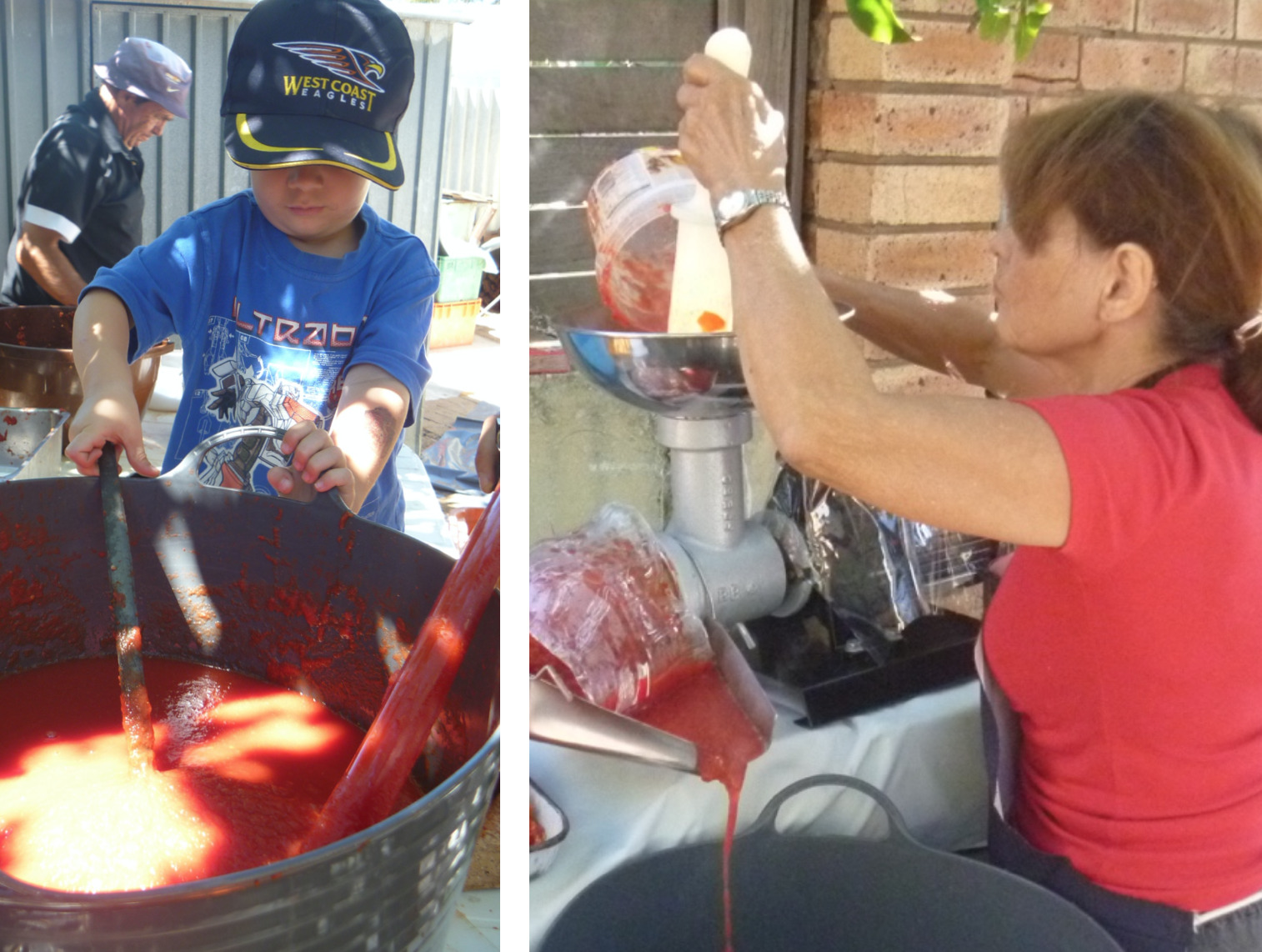
My teenage years and early twenties were filled with processed junk foods: a dizzying array of Hungry Jacks combos, greasy fish and chips, and takeaway meat lovers pizzas.
Cooking was a relaxation practice I stumbled upon much later in life.
Since upping my kitchen game and trading the expensive wellness activities for a sharp knife, solid chopping board, and fresh vegetables, my savings and confidence have grown.
To emerge from the kitchen in a calm and tranquil state, a few conditions have to be in place:
1. You cannot feel rushed
2. Your kitchen counter must be clean and clutter-free
3. You need a sharp knife to chop with
4. Your phone must be out of sight (like most things in life, it’s best not to multitask)
If these conditions are met, cooking can feel like a meditation or an empowering yoga class.
I’m not the only person who feels this way.
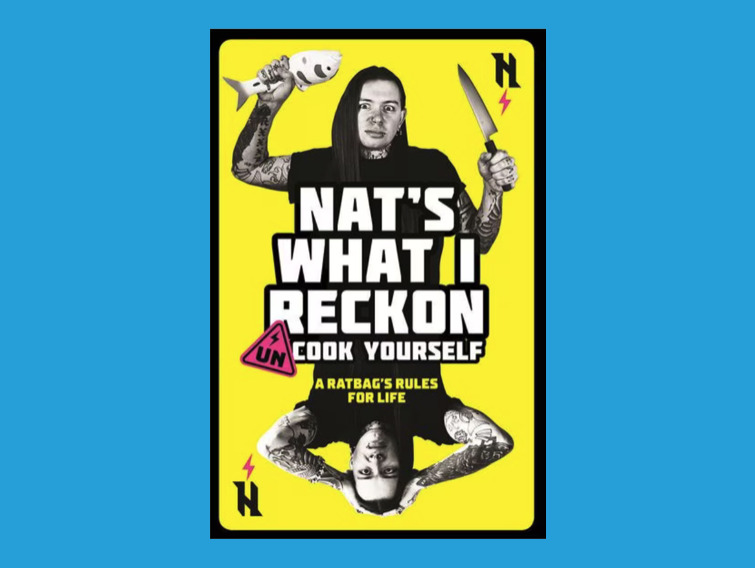
In the book ‘Uncook Yourself: A Ratbag’s Rules for Life’, Nat’s What I Reckon shares how he cooks his way through tough times. He writes:
“I reckon getting in the kitchen and un-cooking yourself from the tough moments in your head every now and then is a way better self-help routine than throwing five grand at some short-lived back pat from a cash grabbing blowhard at a self-help seminar just to tell you you’re not doing life right.”
One reason is you need to focus your mind.
When chopping with a sharp knife, you must pay attention to what you’re doing. If you get distracted, and I have (many times), you might pay the price with a cut to the finger.
Chopping is also a repetitive activity that delivers an immediate outcome. One minute, the bok choy is on the chopping board in full form; the next, it has been chopped and is ready for tonight’s stir-fry.
Cooking also requires you to slow down.
When you’re online, you tend to jump around in a frenzy. But when you’re cooking, you have to follow a recipe step-by-step. This requires focus. This focus helps to clear your mind.
Cooking also gives you a sense of control, power, and agency. As food journalist Michael Pollan says:
“Eating out breeds helplessness, dependence and ignorance, and eventually, it undermines any sense of responsibility.”
When you cook, you’re in control of the process (not some big corporate fast food company). Plus, compared to that commodified wellness experience, cooking is super cheap (all it costs is the price of a few ingredients).
It also produces a nourishing meal at the end. That meal will give you energy, help regulate your mood, and keep you calm and steady.
In the book ‘The Food Mood Connection’, Uma Naidoo argues that to decrease anxiety, you should pay attention to what you’re eating. She writes:
“A crucial part of battling anxiety is making sure your diet is full of foods that are calming and free of foods that put you on edge.”
Fast foods and highly processed foods. These foods (e.g., greasy hot chips and baked goods) are problematic because they lack fibre and the fragile micronutrients and phytochemicals needed for good brain health.
Naidoo recommends increasing your fibre intake by consuming more plants and whole foods, such as beans, brown rice, baked potatoes with the skin on, broccoli, pears, apples, and oats.
A few years ago, I delivered a talk called ‘Rediscovering the Ancient Art of Thrift’ at a local library. In my presentation, I shared the thrifty practice of avoiding eating out and cooking meals at home.
At this point in the presentation, an elderly gentleman put up his hand and said:
“But vegetables are expensive. Why not just get McDonald’s? It’s cheap, and there’s no cleaning up at the end.”
I immediately thought of a friend who, at the time, ate only McDonald’s (for breakfast, lunch, and dinner). His housemates had confided in me that his feet had developed a pungent odour.
Although my diet was far from perfect, I was concerned. If my friend kept going down this path, I could see him heading for serious trouble.
Fast forward a year: How was my friend doing?
He was not well.
He had put on a significant amount of weight and seemed depressed, rarely leaving his room except to get his next McDonald’s meal (back in those days, there was no Uber Eats).
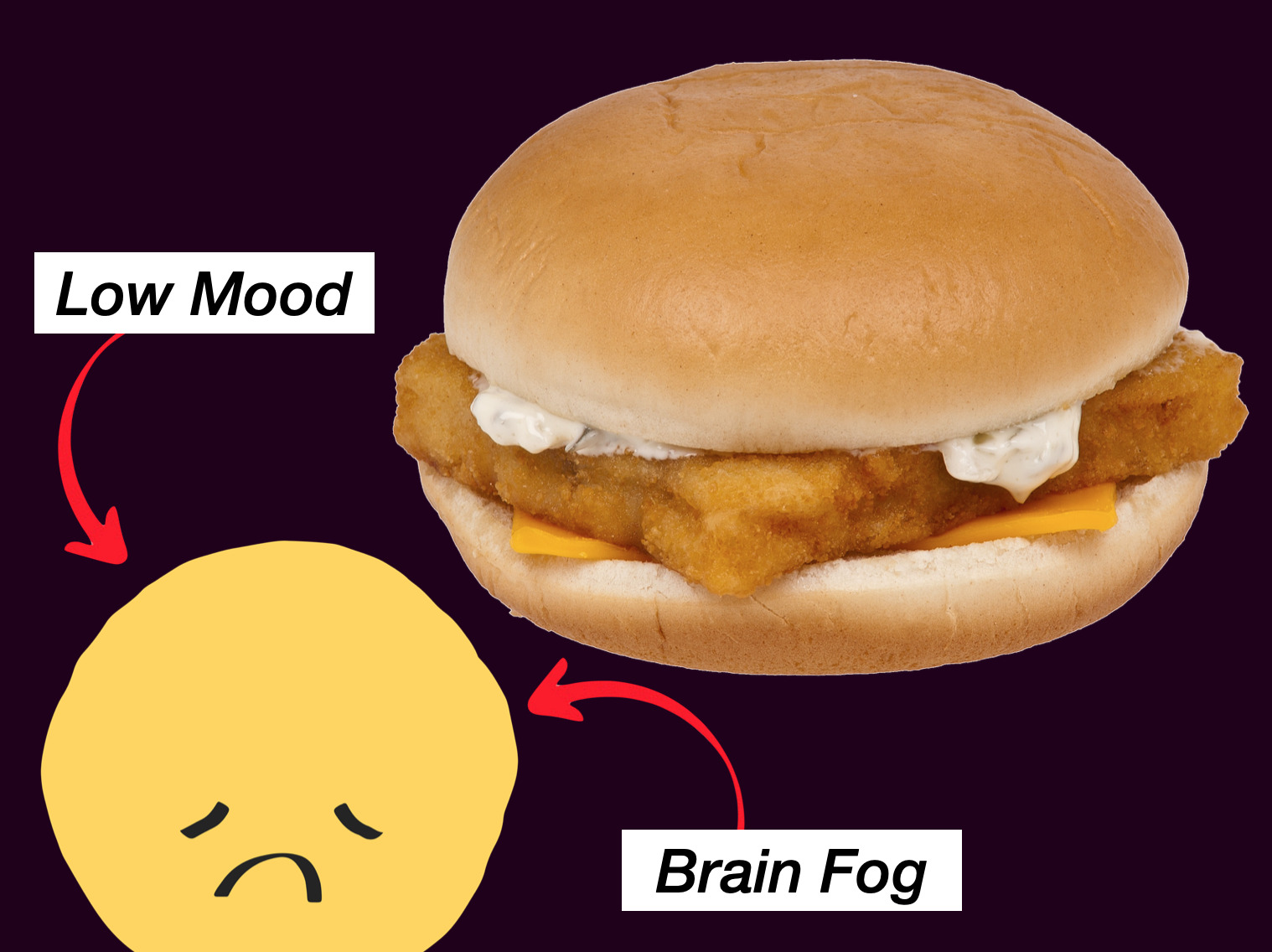
I explained to this elderly gentleman in the library workshop:
“Maybe you’ll save a bit of time and money in the short term [buying the fast food], but eating processed food will cost you down the track. It will cost you in medical bills and poor health. Your quality of life will suffer.”
He nodded, but I could tell he wasn’t entirely convinced.
Until you’ve cut out the processed junk food, allowed a couple of weeks for your tastebuds to readjust, and developed the habit of home cooking, it’s easy to be sceptical. After all, we live in a world that values convenience. Opening an app, pressing a button, and having dinner delivered to your door in less than 20 minutes has some definite appeal.
But every time you order Uber Eats, you miss out on a valuable opportunity to practice slowing down and calming your mind. You also undermine your cooking skills.
If you haven’t developed the habit of cooking or cooking makes you feel anxious, there are a few simple things you can do to cultivate calm and confidence in the kitchen:
Cooking is a messy process. While I may start with a clean kitchen bench, it quickly becomes a mess. That’s how the process goes (I try to clean as I go).
It’s also okay to mess up a meal. Not every meal is going to be an absolute winner. In ‘The Four Hour Chef’, Tim Ferris encourages the reader to see meals that don’t work out as cheap cooking classes. Learn the lesson and move on.
When you think of cooking as one activity, it can feel overwhelming. I divide the cooking process into two stages:
1) Preparing the mise en place: chopping vegetables, taking out utensils, etc, and
2) Pulling it all together: cooking the dish.
In the morning, I take out all the ingredients for a dish so they are ready to go when I need to take a break from my work. I chop earlier in the day and cook the dish in the afternoon/early evening.

If I’m overwhelmed by the idea of chopping vegetables, I break it down to chopping just one vegetable at a time. I’ll say to myself:
“Just chop the capsicum. That’s all you need to do.”
It’s not fun chopping with a knife with a dull blade. A sharp knife combined with a lovely chopping board makes all the difference.
Learning basic chopping skills is a game changer. With the proper technique and a sharp knife, there’s no need to worry about cutting yourself. You can chop with ease.
I took a chopping skills course with the online cooking school Rouxbe, but you can find YouTube videos teaching you good chopping techniques.
You’re not running a restaurant. You don’t have to rush to get meals out to hungry customers. Take your time and enjoy the process of chopping each vegetable.
If approached with the right mindset, cooking can deliver a sense of calm and ground you in the present moment. You also get to experience the mental and physical benefits of a nourishing home-cooked meal. The bonus extra is saving a bit of money.
So, what are you waiting for? Pull out some ingredients and start cooking today.
Dr Jane Genovese delivers interactive and engaging study skills sessions for Australian secondary schools. She has worked with thousands of secondary students, parents, teachers and lifelong learners over the past 15 years.
Get FREE study and life strategies by signing up to Dr Jane’s newsletter:
© 2025 Learning Fundamentals